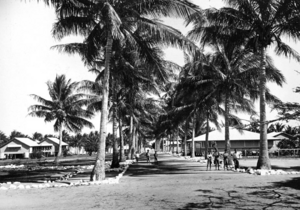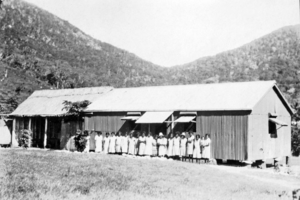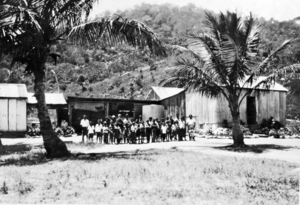Palm Island Aboriginal Settlement facts for kids
The Palm Island Aboriginal Settlement was a special place on Great Palm Island in North Queensland, Australia. It was also known by other names like the Palm Island Aboriginal Reserve or Palm Island mission. This settlement was like a reserve and a penal colony (a place where people were sent for punishment) for Aboriginal people. It became the biggest and strictest reserve in Queensland.
The government officially created the reserve in 1914. However, the first people only arrived in March 1918. They came from another settlement called Hull River, which was destroyed by a cyclone. The government controlled Palm Island until 1975. Palm Island is mentioned in the Bringing Them Home Report. This report talked about the "Stolen Generation", which were Aboriginal children taken from their families and placed in institutions like Palm Island.
Contents
Why Palm Island Was Chosen
In 1909, the Chief Protector of Aborigines visited Palm Island. He was checking on Japanese pearling crews. He found a small group of Aboriginal people living there. In 1916, he said Palm Island was "ideal for a delightful holiday". But he also thought its remote location made it perfect for punishing people the government wanted to control.
How the Settlement Started (1914-1918)
In 1914, the government set up the Hull River Aboriginal Settlement on the mainland. But on March 10, 1918, a powerful cyclone destroyed all its buildings. They were never rebuilt.
Palm Island had already been made an Aboriginal reserve on June 20, 1914. Not many Aboriginal people lived there at that time. After the cyclone, around April 1, 1918, the Hull River settlement moved to Palm Island. The new residents came from many different Aboriginal groups across Queensland. There were at least 57 different language groups. These people later became known as the Bwgcolman people.
The person in charge of Palm Island Aboriginal Settlement was called the Superintendent. He reported to the Chief Protector of Aboriginals. The government controlled every part of the Aboriginal residents' lives. They were considered "wards of the state", meaning the state acted as their guardian.
Life on the Reserve: Rules and Control
In the first 20 years, the number of Indigenous "inmates" grew from 200 to 1,630. By the early 1920s, Palm Island was the largest government Aboriginal settlement. Its remote location was attractive to administrators because Aboriginal people could be kept isolated.
However, Palm Island quickly became known as a place of punishment. People were sent there from all over Queensland. Reasons for being sent included being "disruptive" or being born with mixed heritage. Some were sent after being sentenced by a court or released from prison. Others were sent by administrators of other missions who wanted to remove "ill-mannered" people. For a long time, more people died on the reserve than were born there. The population only grew because more people were sent from the mainland.
Palm Island was used as a prison for Indigenous people who broke the 1897 Protection Act. It also held those who had committed crimes. Many men who had already served time in jail were then moved to the reserve. This meant they were punished a second time for the same offence.
In the 1930s, a local doctor pointed out that people on the island were not getting enough food. He asked the government to give them more food and provide fruit juice for children. But this request was refused.
The reserve had a hospital, two schools, and dormitories for children, women, and young people. There were also churches, a sawmill, and workshops for training in carpentry and plumbing.
A bell tower was built to control daily life. The bell rang every morning at eight. Everyone had to line up for a parade in the mission square. If someone missed the lineup, their food was cut. At nine each evening, the bell rang again, turning off the island's electricity. This roll call and curfew continued until the 1970s. The bell tower still stands today as a reminder of Palm Island's history. People on the island were treated "as rather dull retarded children" by the administrators.
A letter from the "Protector" to a new bride showed how much control they had: "Dear Lucy, Your letter gave me quite a shock, fancy you wanting to draw four pounds to buy a brooch, ring, bangle, work basket, tea set, etc, etc. I am quite sure Mrs. Henry would expend the money carefully for you, but I must tell you that no Aborigine can draw 4/5 of their wages unless they are sick and in hospital and require the money to buy comforts... However, as it is Christmas I will let you have 1/5 – out of your banking account to buy lollies with."
Aboriginal people were not allowed to speak their own languages. They were also forbidden from going into "white" areas. Administrators controlled almost every daily activity. There were nightly curfews, and mail was checked. Sometimes, women were put into dormitories while their husbands were sent to work on the mainland.
Children's Dormitories
In 1922–23, an Industrial School and separate dormitories for children were set up. When children arrived, they were separated from their parents. Boys and girls were also kept apart. The dormitories cared for orphans or neglected children. But they also held single mothers and their children.
New dormitories for boys and girls were built in 1962 and 1965. By 1966, about 71 children lived in them. As ideas about caring for young people changed, fewer children were sent to Palm Island. By 1975, only 27 children were left in the dormitories. They were completely closed on December 5, 1975.
Punishment Island
Some small islands near Great Palm Island were also made reserves in 1941. One of these, Eclipse Island, became known as "Punishment Island". The Superintendent, Mr. Curry, would send men there as punishment. For small misbehaviours like speaking their own language or gambling, men were exiled to Eclipse Island. They were given only bread and water, sometimes for weeks.
1957: The Strike
One of the strictest Superintendents was Roy Bartlam. He would arrest workers for being just a minute late for roll call.
All Islanders had to work 30 hours each week. Until the 1960s, they were not paid for this work. A strike happened because an Indigenous man, Albie Geia, was going to be removed from the island for disobeying a European overseer. The strike was also against the harsh rules, low or no wages, and poor housing and food.
Bartlam had to hide in his office and call for help. Police arrived from Townsville. The leaders of the strike and their families were sent away in chains to other Aboriginal settlements. Seven families were banished from Palm Island in 1957 for taking part in this strike. They were protesting the very difficult working conditions. Cathy Freeman's mother, Cecilia Barber, and the family of strike leader Frederick William Doolan were among those banished.
Palm Island Today
Descendants
Today's population on Palm Island are the descendants of people who were forcibly moved there between 1914 and 1971. These descendants are known as the Bwgcolman people. They represent at least 43, and possibly 57, different Aboriginal language groups. At least 5,000 people were forcibly removed to the reserve from all over Queensland, the Torres Strait Islands, and Melanesian islands. Most of the current population are descendants of people from the region between Bowen and Tully, north-western Queensland, and the Cape York Peninsula.
Challenges Today
Palm Island was the "largest and historically most punitive" (punishing) of Queensland's Aboriginal reserves. Its history has greatly affected the many social and economic problems on the island today. In 2006, reports showed high unemployment and a low average life expectancy of 50 years. This was 30 years less than the Australian average. Experts have said that the island's past as a "penal settlement" and past policies have led to these problems.
Images for kids








